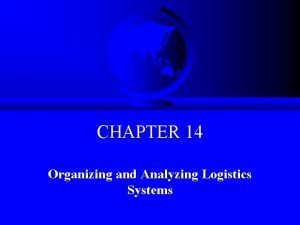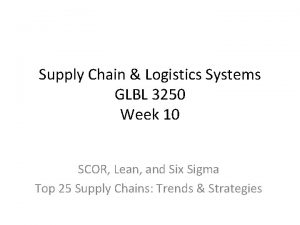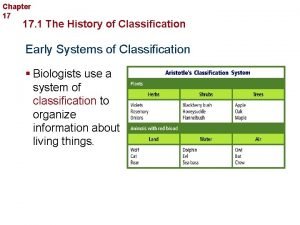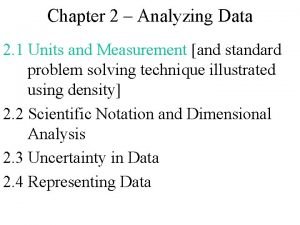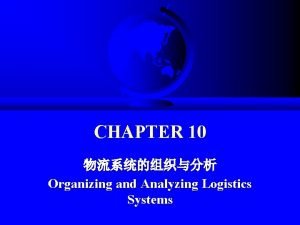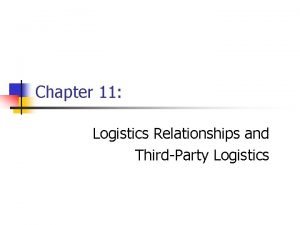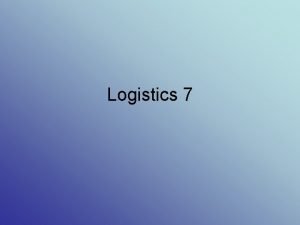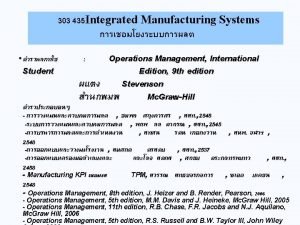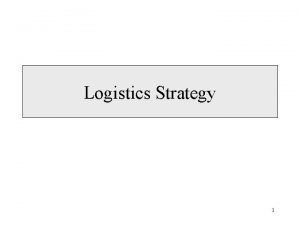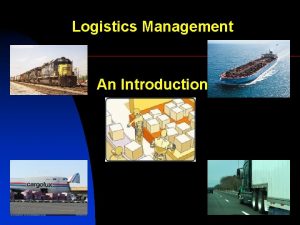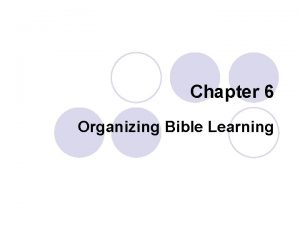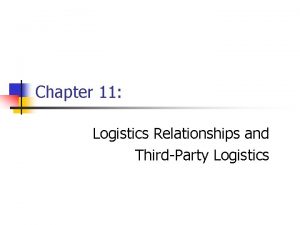CHAPTER 14 Organizing and Analyzing Logistics Systems Learning


















- Slides: 18

CHAPTER 14 Organizing and Analyzing Logistics Systems

Learning Objectives F To examine the problems and opportunities involved in systems analysis F To relate the importance of industry standards to systems analysis F To discuss the steps involved in redesigning a logistics system F To examine a number of organizational alternatives © 2008 Prentice Hall 2

Learning Objectives F To describe a number of techniques for achieving logistics coordination and integration F To distinguish between centralized and decentralized logistics organizations F To distinguish between logistics within the firm and outsourcing logistics activities © 2008 Prentice Hall 3

Logistics Systems: Analysis, Design, and Integration F Key Terms F Key – Benchmarking – Channels audit – Competition audit – Customer audit direct product profitability (DPP) analysis Terms – Environmental sensitivity audit – Existing facilities audit – Integrated service providers © 2008 Prentice Hall 4

Logistics Systems: Analysis, Design, and Integration F Key Terms F Key – Linking-pin organization – Matrix management – Product audit – Simulation – System constraints Terms – Systems analysis – Third-party, or contract, logistics – Unified department organization – Vendor audit © 2008 Prentice Hall 5

What Is Systems Analysis? F Systems analysis refers to the orderly and planned observation of one or more segments in the logistics network or supply chain to determine how well each segment functions © 2008 Prentice Hall 6

General Questions Why do we perform each task? F What value is added by it? F Why are the tasks performed in the order they are? F Can we alter the sequence of the processing steps to increase efficiency? F Why are the tasks performed by a particular group or individual? F Could others perform this task? F Is there a better way for the system to operate? F © 2008 Prentice Hall 7

Problems in Systems Analysis F Multiple business functions are impacted F There are trade-offs among conflicting objectives F Logistics system impacts are difficult to precisely evaluate F There are business issues unique to each logistics system F Quantitative analysis is essential for intelligent decisions © 2008 Prentice Hall 8

Figure 14 -1: A Scoring Checklist Used to Determine Logistics Planning or Strategy Study © 2008 Prentice Hall 9

Partial Systems Analysis F Customer profitability analysis F Warehousing productivity analysis F Transportation cost analysis F Consolidation analysis F Direct product profitability analysis F Benchmarking F Industry standards analysis © 2008 Prentice Hall 10

Logistics System Design F Establishing objectives and constraints F Quality programs F World-class logistics programs F System constraints F Organization of the study team F Data collection © 2008 Prentice Hall 11

Logistics System Design (continued) F Product audit F Existing facilities audit F Vendor audit F Customer audit F Channels audit F Competition audit F Environmental sensitivity audit © 2008 Prentice Hall 12

Figure 14 -7: Flexibility Makes It Easier to Work Together © 2008 Prentice Hall 13

Logistics System Design (continued) F Analysis of the data F Simulation F Design implementation © 2008 Prentice Hall 14

Figure 14 -8: Schematic Drawing of Automated Sorting System © 2008 Prentice Hall 15

Systems Integration: Logistics within the Firm F Dispersion of logistics activities F Achieving coordination F The status quo F The linking-pin concept – Linking-pin organization FA unified department – Unified department organization F Centralized versus decentralized F Matrix management © 2008 Prentice Hall 16

Figure 14 -9: Becton Dickinson’s Worldwide Sources © 2008 Prentice Hall 17

Systems Integration: Logistics Activities Outside the Firm F Third-party, or contract, logistics F Integrated service providers F Monitoring third-party performance © 2008 Prentice Hall 18
 Example of data dictionary in system analysis and design
Example of data dictionary in system analysis and design Chapter 2 worksheet organizing and administering
Chapter 2 worksheet organizing and administering Cuadro comparativo e-learning y b-learning
Cuadro comparativo e-learning y b-learning Partial system analysis in logistics
Partial system analysis in logistics Logistics systems
Logistics systems Analyzing transactions
Analyzing transactions Chapter 17 organizing life's diversity answer key
Chapter 17 organizing life's diversity answer key Analyzing business markets
Analyzing business markets Equation analysis sheet
Equation analysis sheet Chapter 16 responsibilities of owning a vehicle
Chapter 16 responsibilities of owning a vehicle Chapter 2 analyzing data
Chapter 2 analyzing data Chapter 3 analyzing changes in financial position answers
Chapter 3 analyzing changes in financial position answers Chapter 2 analyzing data answer key
Chapter 2 analyzing data answer key Chapter 6 analyzing the audience
Chapter 6 analyzing the audience Analyzing consumer markets chapter 6
Analyzing consumer markets chapter 6 Chapter 3 analyzing changes in financial position answers
Chapter 3 analyzing changes in financial position answers Part two analyzing transactions into debit and credit
Part two analyzing transactions into debit and credit Chapter 4 analyzing investing activities solutions
Chapter 4 analyzing investing activities solutions Lesson 1.8 boxplots and outliers
Lesson 1.8 boxplots and outliers



